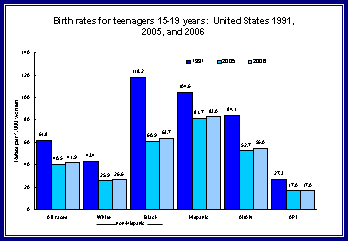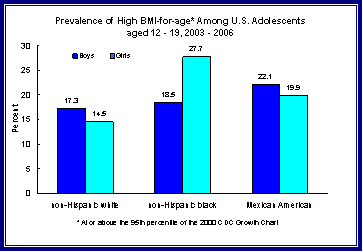Publications and Information Products
Information Sheet
December 2008
NCHS Data on Adolescent Health
PDF version 103KB
Page Content
About NCHS
Adolescent Health Data
Teen Health Status
Teen Reproductive Health
Obesity Among Adolescents
Injury Mortality
Adolescent Health Data Sources
About NCHS
The CDC's National Center for Health Statistics (NCHS) is the nation's principal health statistics agency, providing data to identify and address health issues. NCHS compiles statistical information to help guide public health and health policy decisions.
Collaborating with other public and private health partners, NCHS employs a variety of data collection mechanisms to obtain accurate information from multiple sources. This process provides a broad perspective to help us understand the population's health, influences on health, and health outcomes.
Adolescent Health Data
The health and risk behaviors of adolescents have consequences for their current and long term well-being as well as consequences for society. This document reflects only a few data highlights on adolescent health; however, NCHS collects data on a variety of topics affecting adolescents, including:
Health Care Coverage
Indicators of Health Status
Hospitalizations and Ambulatory Visits
Reproductive Health
Injuries
Death Rates
Teen Health Status
As a common indicator of health, in 2007, adolescents aged 12-19 were asked to rate their health as excellent, very good, good, fair or poor.
- 50 percent reported they were in excellent health;
- 29 percent reported they were in very good health;
- 18 percent reported they were in good health, and 2 percent reported they were in fair or poor health.
Teen Reproductive Health
Following a 14 year downward trend in which teen births fell by 34 percent between 1991 and 2005, the teen birth rate in the U.S. rose in 2006.
- Between 2005 and 2006, the birth rate for teens aged 15-19 rose 3 percent, from 40.5 live births per 1,000 females to 41.9 births per 1,000 in 2006.
- The largest increases were reported for non-Hispanic black teens, whose overall rate rose 5 percent in 2006. The rate rose 2 percent for Hispanic teens, 3 percent for non-Hispanic white teens, and 4 percent for American Indian or Alaska Native teens.
In 2006, pregnant females aged 12-19 made 4.3 million ambulatory visits to either physician offices or hospital outpatient departments for either routine prenatal or unconfirmed pregnancy examinations.

Source: Births: Preliminary Data for 2006, National Vital Statistics Reports
Vol. 56, No. 7: National Center for Health Statistics, 2007.
Obesity Among Adolescents
Obesity among adolescents in the U.S. continues to be a public health concern. The Body Mass Index (BMI)-for-age at or above the 95th percentile was estimated for adolescents aged 12-19 based on the 2000 CDC growth charts.
- In 2003-2006, 17.6 percent of adolescents had high BMI-for-age.
- Almost 28 percent of non-Hispanic black teen girls aged 12-19 and almost 20 percent of Mexican American teen girls had high BMI-for-age compared with 14.5 percent of non-Hispanic white teen girls.
- Among boys aged 12-19, Mexican Americans were more likely to have high BMI-for-age than non-Hispanic whites.

Source: National Health and Nutrition Examination Survey, 2003 – 2006.
Injury Mortality
In 2005, injuries accounted for 75 percent of all deaths among adolescents aged 15-19. In the same year, there were 49.8 injury deaths per 100,000 adolescents aged 15-19, down 2.9 percent from the rate in 2004. The leading causes of death among adolescents are unintentional injuries, homicides and suicides. The following reflect adolescent death rates due to injury in 2005.
- The adolescent unintentional injury death rate was 31.4 deaths per 100,000; 73 percent of the unintentional injuries were motor-vehicle traffic related.
- The adolescent homicide rate was 9.9 deaths per 100,000; 84 percent of the homicides were firearm-related.
- The adolescent suicide rate was 7.7 deaths per 100,000; 46 percent of the suicides were firearm-related and 40 percent of the suicides were by hanging.
Adolescent Health Data Sources:
NCHS employs a variety of data collection mechanisms to obtain accurate information from multiple sources: They include:
- National Health and Nutrition Examination Survey (NHANES) - collects information about the health and diet of people in the U.S. NHANES is unique in that it combines a home interview with physical examinations and laboratory tests conducted in a Mobile Examination Center. NHANES can directly measure conditions and provide reliable information on health conditions regardless of whether the survey respondent is aware of them. (http://www.cdc.gov/nchs/nhanes.htm)
- National Health Care Surveys - a family of provider surveys, obtaining information about the facilities that supply health care, the services rendered, and the characteristics of the patients served. NCHS surveys hospitals, office-based physician practices, emergency and outpatient departments, ambulatory surgery centers, nursing homes, and home health and hospice agencies. These surveys provide a picture of how the delivery system works, and provide an opportunity to learn about patients, their illnesses, and treatment (http://www.cdc.gov/nchs/nhcs.htm)
- National Health Interview Survey – obtains information on the nation’s health status through confidential household interviews that measure: health status and disability, selected conditions, insurance coverage, access to care, use of health services, immunizations, health behaviors, injury, and the ability to perform daily activities. (http://www.cdc.gov/nchs/nhis.htm)
- National Vital Statistics System - obtains information from death certificates in all 50 states and the District of Columbia, including characteristics of the decedent and causes of death. (http://www.cdc.gov/nchs/nvss.htm)
For further information about NCHS and its programs, visit us at http://www.cdc.gov/nchs, or call the Office of Planning, Budget and Legislation at 301-458-4100.
Page Last Modified: December 18, 2008
Data Source: CDC/National Center for Health Statistics
National Center for Health
Statistics
3311 Toledo Road
Hyattsville, MD 20782
Phone:
1-800-232-4636
nchsquery@cdc.gov
Centers for Disease Control and Prevention, 1600 Clifton Rd, Atlanta, GA 30333, U.S.A
Tel: (404) 639-3311 / Public Inquiries: (404) 639-3534 / (800) 311-3435